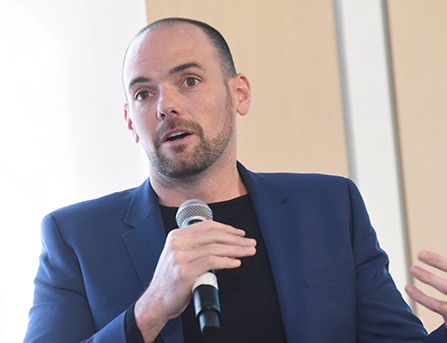Fox Working to Create Interactive Ads for Clients

Forget 30-second spots. Those are going away, says Joe Marchese, president of advanced advertising products for the Fox Networks Group.
Speaking at B&C’s Advanced Advertising conference in New York last week, Marchese said Fox wants to help its advertisers move into the on-demand world by creating for them the kind of advertising that works best when there are opportunities for interactivity, or an immersive experience.
The idea is to take advantage of that most-valuable resource—human attention, something TV squanders when it stuffs too many commercial breaks into the programs people want to see.
Marchese’s boss, 21st Century Fox CEO James Murdoch, is among the TV industry leaders calling for a decrease in the ad loads in shows on their networks.
Marchese said that Fox’s goal is to lower the number of commercials it airs, while keeping revenues about the same…or perhaps a bit higher.
Fox Networks Group last month unveiled its data-driven ad product, called Audience Insights Manager, which taps all the industry’s bells and whistles, including optimization, precision targeting, targeted costs per thousand (TCPMs), multiplatform guarantees and linear programmatic buying.
Naturally, Fox will aim to make the TCPM higher than the current prices it charges. And Marchese its hopeful media agencies will go along with that.
Broadcasting & Cable Newsletter
The smarter way to stay on top of broadcasting and cable industry. Sign up below
“Yes, we would love to make more money. But you’re going to see a trend across the board of ad-load reduction,” he said.
“While my title is advanced advertising, I really like to look at it as, how can we benefit the consumer? How can we maintain an ad business as big as what Fox does across National Geographic and FX and sports in a way that’s consumer friendly?” he said. “Figuring out how to remove as many of the interruptive breaks as possible is incredibly important. And we’re going to try different things.”
Rules of Engagement
Marchese came to Fox last year when 21st Century Fox bought his company, True[x], which used technology to find ways to make viewers more engaged with online advertising. The main way it did that was by offering to let viewers watch fewer commercials if they agreed to watch an interactive ad.
It takes a while for consumers to understand the proposition, but once they get it, they choose to watch the interactive ad more than 80% of the time and often wind up spending much more than 30 seconds with the sponsor’s message.
Marchese says that the current TV video-on-demand experience, with un-skippable ads, might be great for advertisers, but it’s bad for consumers.
“Someone would eat their right arm to get that ad impression that’s that good in a digital environment, and we can’t sell them in TV because it’s like a fly ball that both outfielders run away from,” he said. “It’s not a digital ad and it’s not a TV ad because it’s not bought on a C3, C7 basis.”
When Fox sells multiplatform ad packages, some ads will be linear and others will be on-demand. Measurement will be complicated. “We want unified measurement. We want apples-to-apple, but that might not exist,” Marchese said. But even if measurement companies could put a figure on a unified audience, that “doesn’t mean we want to deliver the same ad in every place.”
Fox’s Advanced Advertising Products Group is working on being able to create ads that are more interactive than those that run on linear networks. “Taking your TV ads and putting them in on-demand environments that are potentially interactive is akin to taking a radio ad and putting it on television. It will work. People are going to hear it. But you’re skipping out on the part of what the value could have been in that,” Marchese said.
“I do think that a new age of creative in advanced ads, a new age of interactive ad formats, will help us with the ad load reduction. And so we’re going to put a lot of effort this year on saying, great—here’s your TV ad and we are going to for cost, or for no cost, build you the interactive, immersive version so that when someone’s watching in a VOD interactive environment we can deliver that ad.”
Fox would also be delivering valuable attention, if not return on investment.
“The real thing a publisher should sell is attention. Television is the most effective form of attention,” he said. But, he added, “there are a number of things that can affect ROI. If I was a consumer, and I was going to write a letter, it would be: ‘Dear networks and advertisers, your ROI is not my problem. Signed, the Consumer.’”
Jon has been business editor of Broadcasting+Cable since 2010. He focuses on revenue-generating activities, including advertising and distribution, as well as executive intrigue and merger and acquisition activity. Just about any story is fair game, if a dollar sign can make its way into the article. Before B+C, Jon covered the industry for TVWeek, Cable World, Electronic Media, Advertising Age and The New York Post. A native New Yorker, Jon is hiding in plain sight in the suburbs of Chicago.










